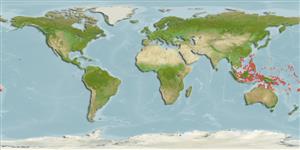Common names from other countries
Environment: milieu / climate zone / depth range / distribution range
Ecologia
marinhas; Água doce; estuarina demersal; anfídromo (Ref. 51243). Tropical; 29°N - 20°S
Asia and Oceania: Ryukyu Islands in Japan, Taiwan, Philippines, Indonesia, Solomon Islands, New Guinea and northern Australia. Reported from Palau (Ref. 6371), Fiji (Ref. 12743) New Caledonia (Ref. 13235) and Vanuatu (Ref. 97791).
Tamanho / Peso / Idade
Maturity: Lm ? range ? - ? cm
Max length : 14.0 cm SL macho/indeterminado; (Ref. 7050)
Espinhos dorsais (total): 7; Raios dorsais moles (total): 9; Espinhos anais 1; Raios anais moles: 8. Distinguished by the following characters: mouth moderate; reaching to a point below anterior margin to middle of eye; operculum with a small patch of 10-20 scales dorsally in 2-3 longitudinal rows; second dorsal rays I,8; pectoral rays 18-21 (usually 19 or 20); predorsal scale count 15-19; one or usually two small lateral canal head pores above anterior operculum just before terminal lateral canal pore; papilla line 6 well developed; papilla lines composed of a single row of papillae; snout length 11.6-13.6% SL ; body with 5 oval, horizontally elongate brown to black spots on midside from second dorsal origin to posterior end of caudal peduncle; spots usually bordered by faint brown lines above and below.
Adults live in clear streams, usually close to the sea (Ref. 5259). They occur mainly in fresh water, but larvae in marine environment (Ref. 5259).
Life cycle and mating behavior
Maturidade | Reprodução | Desova | Ovos | Fecundidade | Larvas
Allen, G.R., 1991. Field guide to the freshwater fishes of New Guinea. Publication, no. 9. 268 p. Christensen Research Institute, Madang, Papua New Guinea. (Ref. 2847)
Categoria na Lista Vermelha da IUCN (Ref. 130435)
CITES (Ref. 128078)
Not Evaluated
Ameaça para o homem
Harmless
Utilização humana
Pescarias: pouco comercial
Mais informação
Nomes comunsSinónimosMetabolismoPredadoresEcotoxicologiaReproduçãoMaturidadeDesovaFecundidadeOvosDesenvolvimento dos ovos
ReferênciasAquaculturaPerfil para aquaculturaEstirpesGenéticaElectrophoresesHereditariedadeDoençasProcessamentoMass conversion
ColaboradoresFotografiasStamps, Coins Misc.SonsCiguateraVelocidadeTipo de nataçãoÁrea branquialOutras referênciasCérebrosVisão
Ferramentas
Relatórios especiais
Descarregue XML
Fontes da internet
Estimates based on models
Preferred temperature (Ref.
115969): 27.1 - 29.3, mean 28.7 (based on 1441 cells).
Phylogenetic diversity index (Ref.
82804): PD
50 = 0.5000 [Uniqueness, from 0.5 = low to 2.0 = high].
Bayesian length-weight: a=0.01023 (0.00477 - 0.02194), b=3.02 (2.84 - 3.20), in cm Total Length, based on LWR estimates for this (Sub)family-body shape (Ref.
93245).
Nível Trófico (Ref.
69278): 3.3 ±0.42 se; based on food items.
Resiliência (Ref.
120179): Elevada, tempo mínimo de duplicação da população menor que 15 meses (Preliminary K or Fecundity.).
Fishing Vulnerability (Ref.
59153): Low vulnerability (10 of 100).
